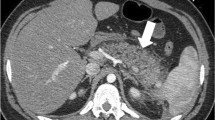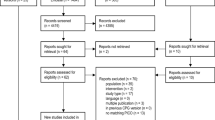Abstract
The objective of the study is to describe the causes of cardiac arrest and complications of cardiopulmonary resuscitation (CPR) on thoraco-abdominal CT examinations for resuscitated patients in our institution. We evaluated the causes of cardiac arrest on thoraco-abdominal CT scans, which was compared with the final diagnosis (determined by consensus of two emergency physicians based on the clinical, imaging, and laboratory findings). Additionally, we evaluated the complications of CPR on thoraco-abdominal CT scans. From March 2005 to August 2011, 82 patients underwent CT of the thorax (n = 77) and abdomen (n = 23) within 24 h after CPR. Final diagnosis was as follows: cardiac (n = 29), respiratory (n = 28), metabolic (n = 11), exsanguination (n = 5), cerebral (n = 2), sepsis (n = 1), and indeterminate (n = 6). In 25 patients (30 %), thoraco-abdominal CT scans made the role either as a definitive study (n = 22) or as a supportive test (n = 3) for the diagnosis. In particular, CT was critical in diagnosis of many respiratory causes (64 %) and all exsanguinations. The most common complications following CPR were skeletal chest injuries (n = 48), followed by lung contusion (n = 45). Thoraco-abdominal CT examinations are helpful for the diagnosis of cause of cardiac arrest and complications of CPR.



Similar content being viewed by others
References
Cummins RO, Ornato JP, Thies WH, Pepe PE (1991) Improving survival from sudden cardiac arrest: the “chain of survival” concept. A statement for health professionals from the Advanced Cardiac Life Support Subcommittee and the Emergency Cardiac Care Committee, American Heart Association. Circulation 83:1832–1847
Neumar RW, Barnhart JM, Berg RA, Chan PS, Geocadin RG, Luepker RV, Newby LK, Sayre MR, Nichol G (2011) Implementation strategies for improving survival after out-of-hospital cardiac arrest in the United States: consensus recommendations from the 2009 American Heart Association Cardiac Arrest Survival Summit. Circulation 123:2898–2910
Rea TD, Eisenberg MS, Sinibaldi G, White RD (2004) Incidence of EMS-treated out-of-hospital cardiac arrest in the United States. Resuscitation 63:17–24
Kurkciyan I, Meron G, Behringer W, Sterz F, Berzlanovich A, Domanovits H, Mullner M, Bankl HC, Laggner AN (1998) Accuracy and impact of presumed cause in patients with cardiac arrest. Circulation 98:766–771
Brody AS, Seidel FG, Kuhn JP (1989) CT evaluation of blunt abdominal trauma in children: comparison of ultrafast and conventional CT. AJR Am J Roentgenol 153:803–806
Mirvis SE (2005) Imaging of acute thoracic injury: the advent of MDCT screening. Semin Ultrasound CT MR 26:305–331
Sivit CJ, Taylor GA, Eichelberger MR (1989) Chest injury in children with blunt abdominal trauma: evaluation with CT. Radiology 171:815–818
Naples R, Ellison E, Brady WJ (2009) Cranial computed tomography in the resuscitated patient with cardiac arrest. Am J Emerg Med 27:63–67
Inamasu J, Miyatake S, Suzuki M, Nakatsukasa M, Tomioka H, Honda M, Kase K, Kobayashi K (2010) Early CT signs in out-of-hospital cardiac arrest survivors: temporal profile and prognostic significance. Resuscitation 81:534–538
Stein PD, Fowler SE, Goodman LR, Gottschalk A, Hales CA, Hull RD, Leeper KV Jr, Popovich J Jr, Quinn DA, Sos TA, Sostman HD, Tapson VF, Wakefield TW, Weg JG, Woodard PK (2006) Multidetector computed tomography for acute pulmonary embolism. N Engl J Med 354:2317–2327
Kuisma M, Alaspaa A (1997) Out-of-hospital cardiac arrests of non-cardiac origin. Epidemiology and outcome. Eur Heart J 18:1122–1128
Hoffmann U, Pena AJ, Moselewski F, Ferencik M, Abbara S, Cury RC, Chae CU, Nagurney JT (2006) MDCT in early triage of patients with acute chest pain. AJR Am J Roentgenol 187:1240–1247
White C, Read K, Kuo D (2006) Assessment of chest pain in the emergency room: what is the role of multidetector CT? Eur J Radiol 57:368–372
Malbranque G, Serfaty JM, Himbert D, Steg PG, Laissy JP (2011) Myocardial infarction after blunt chest trauma: usefulness of cardiac ECG-gated CT and MRI for positive and aetiologic diagnosis. Emerg Radiol 18:271–274
Taki K, Kato H, Hirahara K, Ito Y (1998) Difficulty to diagnose the cause of death in emergency room. Nihon Hoigaku Zasshi 52:223–226
Cho SH, Kim EY, Choi SJ, Kim YK, Sung YM, Choi HY, Cho J, Yang HJ (2013) Multidetector CT and radiographic findings of lung injuries secondary to cardiopulmonary resuscitation. Injury 44:1204–1207
Kim EY, Yang HJ, Sung YM, Cho SH, Kim JH, Kim HS, Choi HY (2011) Multidetector CT findings of skeletal chest injuries secondary to cardiopulmonary resuscitation. Resuscitation 82:1285–1288
Camden JR, Carucci LR (2011) Liver injury diagnosed on computed tomography after use of an automated cardiopulmonary resuscitation device. Emerg Radiol 18:429–431
Engelken FJ, Bosse G, Diederichs G (2011) A complication of cardiopulmonary resuscitation. Emerg Med J 28:173
Fitchet A, Neal R, Bannister P (2001) Lesson of the week: splenic trauma complicating cardiopulmonary resuscitation. BMJ 322:480–481
Offerman SR, Holmes JF, Wisner DH (2001) Gastric rupture and massive pneumoperitoneum after bystander cardiopulmonary resuscitation. J Emerg Med 21:137–139
Conflict of interest
The authors declare that they have no conflict of interest.
Author information
Authors and Affiliations
Corresponding author
Additional information
Seung Joon Choi and Hyung Sik Kim contributed equally to this work.
Rights and permissions
About this article
Cite this article
Choi, S.J., Kim, H.S., Kim, E.Y. et al. Thoraco-abdominal CT examinations for evaluating cause of cardiac arrest and complications of chest compression in resuscitated patients. Emerg Radiol 21, 485–490 (2014). https://doi.org/10.1007/s10140-014-1218-0
Received:
Accepted:
Published:
Issue Date:
DOI: https://doi.org/10.1007/s10140-014-1218-0




